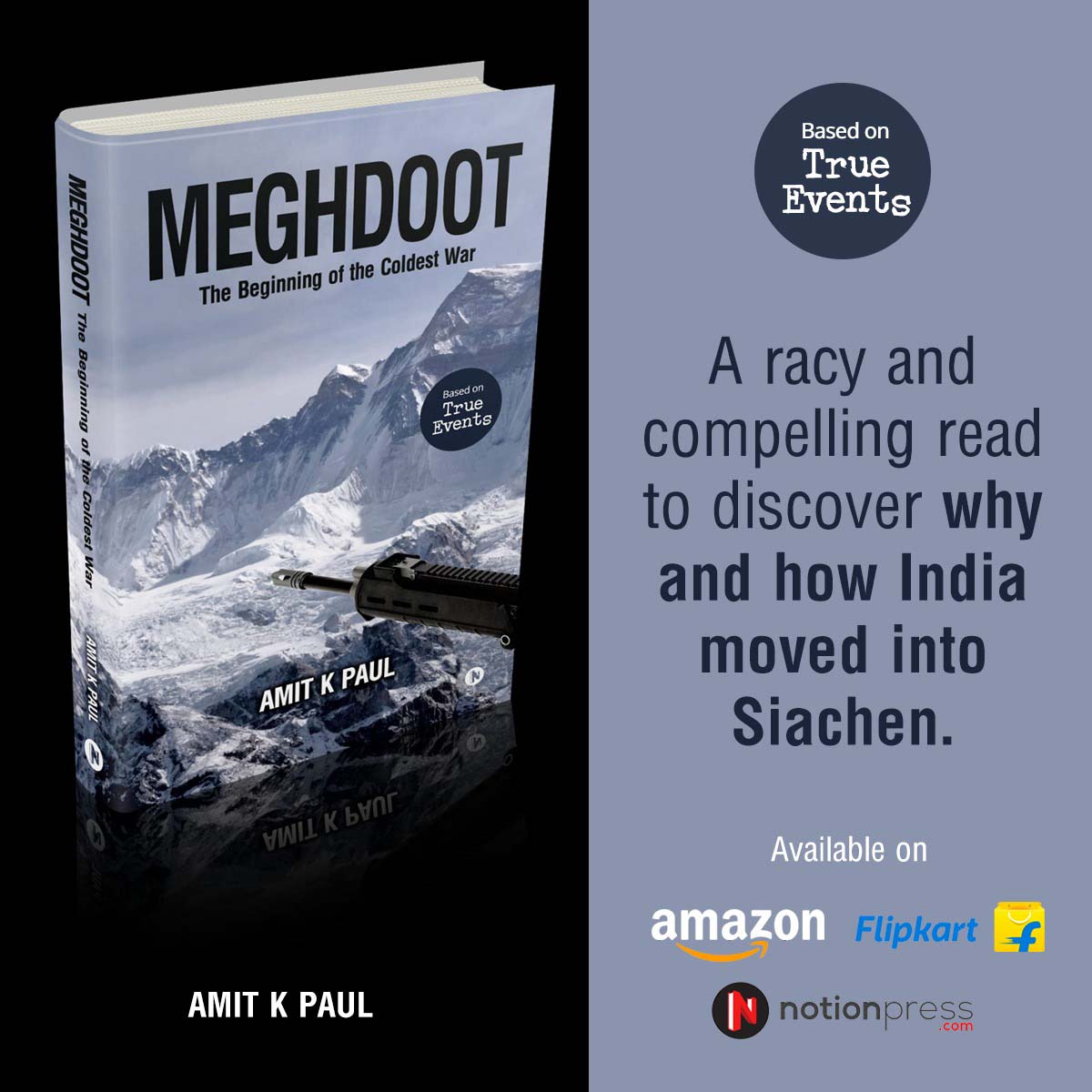Book Title: Meghdoot: The Beginning of the Coldest War
Author: Amit K Paul
Publisher: Notion Press
Pages: 213 in paperback
Price: Rs. 220/-
Siachen, which in the Balti language (of Baltistan) means a land with an abundance of roses, is the name of one of the five largest glaciers in the East Karakoram Range of the Northern Himalayas. At an average altitude of 5,400 meters (17,700 feet) above sea level, it is considered as the highest and coldest in the world. The name itself is most ironic as not a blade of grass grows in that entire area.
Lt Gen Sanjay Kulkarni (Retd), who as a young Captain of 4 Kumaon was the first to jump down from a helicopter at Bilafond La on 13 April 1983, the first of actions which started Operation Meghdoot, has written the Foreword of this book. The induction of 4 Kumaon into Bilafond La resulted in India beating Pakistan in the race to occupy the Saltoro Heights, a decision taken after deliberations at the highest levels. What would these discussions have been? Why was this particular course of action chosen? What is the basis for both India’s and Pakistan’s claims on Siachen? Which agreement is applicable to the region and what is the correct factual matrix for interpreting the same? It is these questions which the book seeks to answer.
Based on true events and facts collected after extensive original and in-depth research, personal interviews, and wide painstaking research on the subject, this book tells the story of the race to Siachen- from the discovery of the cartographic aggression in 1978 by Col Narendra ‘Bull’ Kumar to the battle at Bilafond La in June 1984. Delving deep into the genesis of the dispute, Amit Paul examines the legality of the Indian and Pakistani case and rather than writing in the research format, he has used a very unconventional diary and dialogue format to present all the facts and arguments logically and chronologically. The result is that the book reads like a thriller and will thus appeal to a wider audience including the layman interested in understanding the ‘how and why’ of this dispute.
This is perhaps the first book on this subject which examines the relevant clauses of the Karachi Ceasefire Agreement of 1949 and its applicability to this region. While doing so Paul differs with the views presented by many scholars and authors on this subject in the past and makes some important points which were hitherto overlooked or not given their due importance. These include the following: (a) The Karachi Ceasefire Agreement of 1949 and in particular Clause B2(d) and C of it deal with this area explicitly and very clearly give it to India, which is a basic fact not highlighted by many others who have written on the subject.
Unfortunately, demarcation of the region, which was to be done subsequent to the Agreement, was not done which leaves it incomplete. (b) NJ 9842 is not the terminal point as per the agreement but only the last demarcated point on the ground en-route to the glaciers, lying between Khor and the glaciers. It cannot be the terminal point because the agreement clearly mentions that the ceasefire line must proceed North to the glaciers and be drawn in a manner so as to eliminate all no man’s land. So, the line could not have stopped before the glaciers and be left hanging, thereby creating a large tract of no man’s land.
If the demarcating teams could not complete the demarcation process as per the mandate of the agreement and the field commanders terminated it at NJ 9842 on account of practical difficulties, then it does not make the intent expressed in the agreement vague or give any one any reason to misinterpret it or sanction the creation of a no man’s land contrary to it. (c) The Simla Agreement does not apply to the region beyond NJ 9842 and the only legal document which deals with it is the Karachi Ceasefire Agreement. Contrary to what is widely written, there is no reference to the Line of Control going eastwards from Thang to the Glaciers in the Simla Agreement. (d) The line claimed by Pakistan to extend from NJ 9842 to the Karakoram Pass was not even conceived or drawn in Pakistan. The bulwark of the Pakistani claim for areas north of the line joining NJ 9842 with the Karakoram Pass had been that at some point of time many international cartographers had shown this region on Pakistan’s side.
Declassified documents reveal that the genesis of this cartographic “error” was the office of the US State Department Geographer Robert D Hodgson, who in 1968 unilaterally extended the ceasefire line from NJ 9842 to the Karakoram Pass, taking a cue from the US ADIZ (Air Defence Identification Zone) Maps while dealing with the question of how the boundaries of the state of J & K were to be shown in US maps. Indeed, the line being claimed by Pakistan as its own was never even drawn by it. It is pertinent to mention that in 1986 the US State Department removed this line from all its maps only after a query was raised by India and no suitable explanation was given as to why it appeared in the first place.
Some very challenging and hair-raising first-ever actions of the Indian Army and Air Force in Op Meghdoot in the world’s most challenging terrain and climatic conditions as well as Pakistan Army’s actions and planning for Operation Ababeel add much value to the book which is a must read for all policy makers, diplomats, military personnel, academics and others who have an interest in Siachen.

The writer is editor WordSword Features. He is also a strategic analyst and former spokesperson, Defence Ministry and Indian Army, and can be contacted at wordsword02@gmail.











